The multitude of balloons and pre-performance live music on the Promenade (courtesy of the musicians of NYCB orchestra) added to the festive atmosphere of the celebration of George Balanchine’s birthday, known as “Saturday at the Ballet with George,” held this year on January 27.
The evening program of the celebration comprised some of the most beloved works by Balanchine—“Divertimento No. 15,” “The Four Temperaments,” and “Chaconne”—a finely balanced bill that offered a variety of musical and choreographic styles, ranging from pure classicism to stark modernism to poetic baroque.
“Divertimento No. 15” is one of Balanchine’s indisputable masterpieces. It’s a gleaming example of 19th century ballet classicism and a node to the choreographer’s heritage and artistic roots (by way of Marius Petipa).
Balanchine regarded Mozart’s “Divertimento No. 15 in B-Flat Major” as the finest divertimento ever written and was compelled to return it again and again during his career. The first choreographic take on the score, with a beautiful name “Caracole,” premiered in 1952. This was to be a new Mozart ballet to replace Balanchine’s lost “Symphonie Concertante,” which was created for Ballet Society (a precursor to NYCB) in 1947.
Sadly, “Caracole” didn’t live long enough either—the choreography was too soon forgotten; and four years later, Balanchine made a totally different piece to the Mozart’s score, naming it after the music to which it was set. “Divertimento No. 15” survived the test of time, firmly establishing itself as one of the staples of NYCB’s repertory.
One of the most interesting—and unique—aspects of “Divertimento” is its asymmetric structure of the choreography for the soloists. Instead of the usual even number of principal couples, here there are five leading ballerinas and three cavaliers, plus an eight-member female corps de ballet. This “five-to-three” choreographic puzzle—and how Balanchine was able to solve it—is one the chief pleasures of this piece.
During the performance, the entire cast rose to the occasion. The female leads – Megan Fairchild, Sterling Hyltin, Lauren King, Ashley Laracey, Abi Stafford – were in a fine form, dancing with effervescence and technical finesse. A great allegro dancer, Fairchild stood out for her rapid, quicksilver footwork; and the poetic and supremely musical Laracey shone in her solo variation, rendering, with a sensitive touch, the phenomenal intricacies of the choreography. The suave and capable male contingent included Daniel Applebaum, Andrew Scordata, and Chase Finley.
Yet it was the terrific performance of “The Four Temperaments” that made for the most memorable dance of the evening.
Choreographed in 1946 (originally for Ballet Society) and set to the astringent score by Paul Hindemith, “The Four Temperaments” is a fascinating amalgam of “unclassical” movements—flexed feet, bent knees, angled arms, curved torsos, twisted backs—which, nevertheless, are uniformly based on the classical ballet lexicon. It is one of NYCB’s signature ballets and a brilliant example of Balanchine’s black-and-white canon.
In the opening “Theme,” the three couples, one by one, took center stage, setting from the start the angular and stark aesthetics of the piece. Lydia Wellington and Peter Walker, in the first duet, made a particular impression, bringing strong skills and an enigmatic flair to their convoluted dance-dialogue.
The main variations followed next, each of them representing “an abstract kinetic gloss” on the medieval concept of four different humors.
Merging pathos with desperation, Sean Suozzi was convincing as a regret-laden Melancholic, his body relentlessly downward-sinking as if being pulled down by an unbearable weight. The lively Tiler Peck, ably partnered by Tyler Angle, dazzled as a vivacious Sanguinic. The lanky and ever-solemn Ask la Cour gave an excellent reading of the solo in the Phelgmatic variation—controlled, assured, magnetic. A long-limbed beauty, Teresa Reichlen, delivered a spellbinding account of the Choleric solo, curving gorgeous shapes in the air and sprucing her dancing with a bit of cool glamour.
The performance of “Chaconne,” however, felt underwhelming. Sara Mearns was her magnificent self in the opening duet accompanied by the lovely melancholy of Gluck’s “The Dance of the Blessed Spirits,” yet she had little rapport with her partner, Adrian Danchig-Waring, who was far from his very best form; and the second part of the ballet, with its elaborate courtly ensembles, looked somewhat disjointed and under-rehearsed.









comments